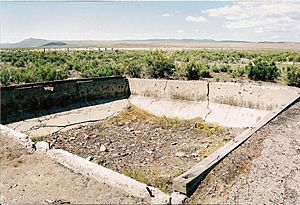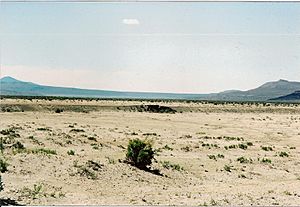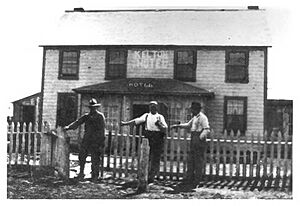Kelton, Utah facts for kids
Quick facts for kids
Kelton, Utah
|
|
|---|---|

Empty foundation at Kelton
|
|
| Country | United States |
| State | Utah |
| County | Box Elder |
| Founded | 1869 |
| Abandoned | 1942 |
| Elevation | 4,229 ft (1,289 m) |
| GNIS feature ID | 1437603 |
Kelton is a ghost town in Utah, United States. It is located just north of the Great Salt Lake in Box Elder County. A ghost town is a place where people used to live, but now it is mostly empty.
Kelton was an active town from 1869 to 1942. It started as an important stop on the First transcontinental railroad. The town's life depended on the railroad. Kelton faced big problems in the 1880s when its busy stagecoach route to Boise, Idaho closed. More trouble came in the 1900s when the main rail line moved away. A very strong earthquake hit in 1934, causing damage. But Kelton truly became a ghost town when the railroad tracks were completely removed during World War II.
Contents
The Story of Kelton
The area where Kelton stands was first called Indian Creek. It was settled on April 12, 1869. This was when mostly Chinese workers from the Central Pacific Railroad arrived. This happened less than a month before the famous golden spike was driven. The town's post office opened on December 16, 1869. It was named Kelton after an early cattle rancher.
Kelton quickly grew into a busy town. It soon had nice hotels, stores, and homes. There were also many saloons and gambling halls. The town even had a telephone exchange, which was a big deal back then.
Kelton's Busy Stagecoach Route
Kelton was in a great spot to connect the railroad to big markets in Oregon, Idaho, and Montana. By the summer of 1869, a stagecoach route was set up. It ran between Kelton and Boise, Idaho. By 1871, the Kelton Freight Road was the best road into southwestern Idaho.
In the 1870s and early 1880s, the Wells Fargo stage line was very active. This line ran between Kelton and several gold mines in Idaho and Montana. It was robbed more often than any other stage line in the Old West. People still look for the large amounts of money rumored to be hidden near the City of Rocks.
Why Kelton Became a Ghost Town
| Historical population | |||
|---|---|---|---|
| Census | Pop. | %± | |
| 1870 | 101 | — | |
| 1880 | 135 | 33.7% | |
| 1890 | 77 | −43.0% | |
| 1900 | 85 | 10.4% | |
| 1910 | 58 | −31.8% | |
| 1920 | 50 | −13.8% | |
| 1930 | 47 | −6.0% | |
| 1940 | 33 | −29.8% | |
The Kelton freight road became less important over time. This happened as new railroads, like the Oregon Short Line Railroad and the Utah Northern Railroad, reached into Oregon, Idaho, and Montana. By July 1884, the stagecoach route was no longer used.
The Railroad Moves Away
Even though the stagecoach route closed, Kelton still had the transcontinental railroad. But this changed in 1903 and 1904. The main rail line was moved south to a new route called the Lucin Cutoff. This new route went right across the Great Salt Lake.
Kelton's old section of the railroad became just a backup line. It was used only if there was high water or to serve local farmers and ranchers. There was so little train traffic that the weekly local train would often stop. People would sometimes get off for a half-hour to go rabbit hunting.
The Big Earthquake
On the morning of March 12, 1934, Kelton was hit by the strongest earthquake ever recorded in Utah. It had a magnitude of 6.6. This earthquake, called the Hansel Valley quake, caused a lot of damage. If it had happened in a crowded area, it would have been terrible. But only two people died.
Huge cracks and holes opened in the ground. Muddy water gushed out of them. Houses and other buildings shook badly. The Kelton schoolhouse was left leaning so much that it had to be abandoned.
The Final End of Kelton
As late as 1937, Kelton was still an important local shipping point. About 47 people still lived there. But the town's final end came quickly. The Southern Pacific Railroad completely took apart the old railway line in just one week. This happened from July 1 to 8, 1942. The railroad parts were given to help the war effort.
The last people living in Kelton left. Some even took their houses with them. Today, only some ruins, fallen buildings, and old foundations remain. There is also a decaying cemetery. The old railroad path is still easy to see. However, many of the trestles (bridges) are falling apart.
Climate
Kelton has a semi-arid climate. This means it is usually dry, but not a desert. It gets some rain, but not a lot. On climate maps, this type of climate is shown as "BSk".





